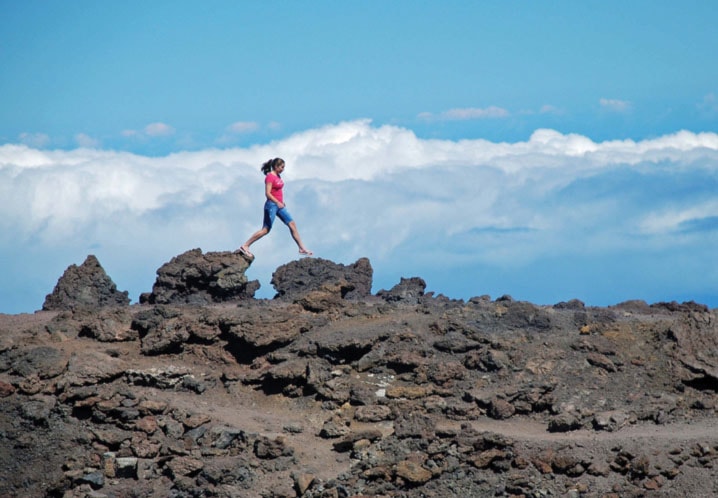While most tourists come to Maui to worship the sun on its white sand beaches, locals consider the mountains and rainforests to be their most sacred places.
For them, the true magic of the island is found in the wilderness near waterfalls, rainforests and volcanoes. To discover these places is to find the real Maui.
The Magic Isle is the second largest island of the archipelago and has an incredibly diverse terrain that supports a mind boggling array of trees, flowering plants, birds, insects and animals.
Hiking trails are abundant and geared to varying levels of difficulty, so even those on a short visit can get out and discover the “mana” (power) of these remote places. Here are three great hikes that open the door to the magic that Maui is famous for.
Iao Valley State Park
In Hawaiian, the word Iao is pronounced “ee-ow” and means “cloud supreme” and for centuries the area of Maui known as the Iao Valley has been considered sacred. The famous phallic stone known as the Iao Needle represents Kanaloa, the Hawaiian god of the underworld and the lush valley surrounding it is an important site for the Hawaiian god Kane, the procreator and provider of life. This valley is one of the wettest spots on the planet and Kane has always been associated with fresh water in all its forms, including clouds, rain, streams and springs.
There is a paved interpretive trail through the park and when you see the towering emerald peaks and the lush valley that surround them it isn’t hard to see why this area has always been a spiritually significant region of the island. You can feel a special kind of peace in Iao Valley State Park. The ridge top lookout provides excellent views of the Iao Needle, the valley and Kahului Harbor and a walk through the botanical gardens will introduce you to many of the plants on the island.
Hint: The top of the Iao Needle is often obscured by clouds in the afternoon. Go early to get the best views and to avoid tour bus groups.
Haleakala
Early Hawaiians called the giant peak that dominates Maui Haleakala, which means “house of the sun.”
In Hawaiian mythology, the crater of the volcano was home to the grandmother of the demigod Maui. Today it is a national park with extensive hiking trails winding through the stark volcanic landscape.
From the summit area of the park, you’ll find hikes ranging from 400 metres to day-long adventures. Along the trails and throughout the park you will find endangered species of plants and animals, some of which exist nowhere else in the world. The national parks service operates several campgrounds and 3 cabins inside the crater, so visitors can stay overnight in one of the island’s most sacred and unique locales.
Hint: Wear warm clothing. The peak of Haleakala sits at more than 3,000 metres above sea level and it gets cold — especially at night.
Guided hiking — Twin Falls
“I think of our valleys as museums,” said our guide Nicholas Batres from Hike Maui. “There’s so much to see and talk about when you’re hiking in Maui and it’s nice to have someone to show you around when you are hiking a trail for the first time.”
The East Maui Waterfalls and Rainforest Hike took us along one of the most popular valleys on Maui’s famous Hana Hwy. The six-hour excursion led to two waterfalls where we had the option to climb along rock ledges and leap into the large natural pools below.
Along the way, we passed an abundant array of plants and our guide knew the name of every one of them.
Hint: Book a guided hiking adventure online and get a discount by visiting: www.hikemaui.com. Guided hikes start at $75 per person, with tax, and include transportation and lunch.
Maui hiking tips
• Be prepared — good shoes, light pants or shorts, sunscreen, mosquito repellent (in rainforest areas), water, food and a cellphone are basic essentials on most hikes.
• For longer hikes, it’s a good idea to bring a backpack with additional water and food, a jacket, a first-aid kit, a flashlight, a compass and a map. For overnight treks, you can rent camping gear from a new company called Camp Maui (campmaui.net).
• It’s always wise to avoid hiking alone but if you are alone, be sure to tell someone where you are going. Stick to trails to avoid getting lost and to avoid damaging sensitive ecosystems. Don’t drink water directly from freshwater ponds or streams.
Doin’ it like a local
When local Hawaiians explore another island, they tend to stay in a bed and breakfast or an intimate family-owned inn. Such places traditionally include breakfast with your stay and offer personal touches that just aren’t possible at large resorts. Many are close to the best hiking spots on the island.
On a recent visit to Maui, we stayed at the Old Wailuku Inn at Ulupono, which proved to be a great starting point for hikes in Iao Valley, Haleakala National Park, and explorations along the Hana Hwy. Honoured by the Hawai’i Visitors and Convention Bureau as “the most Hawaiian accommodation in the entire state,” this lovely seven-room bed and breakfast provides an authentic Hawaiian experience in an historic Hawaiian home. The inn is incredibly comfortable and includes a wonderful breakfast made from locally-sourced ingredients. Rates start at $165 per night for two guests. For reservations or information, visit: www.mauiinn.com.
Debbie Olsen is a Lacombe-based freelance writer. If you have a travel story you would like to share or know someone with an interesting travel story who we might interview, please email: DOGO@telusplanet.net or write to: Debbie Olsen, c/o Red Deer Advocate, 2950 Bremner Ave., Red Deer, Alta., T4R 1M9.
